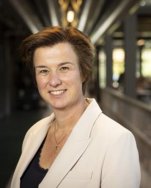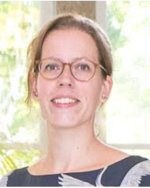Staff shortages, rising costs, and increasing demand are placing immense pressure on the healthcare system and making its future uncertain. Innovations are essential to address these challenges. That’s why the four universities of technology, through the 4TU.Health centre, are joining forces with the STZ hospitals. Together, they improve, connect and accelerate healthcare innovations. By combining hands-on experience from healthcare practice with scientific knowledge and technological advancement, they create solutions that truly transform healthcare — and deliver value for large groups of patients.
A top clinical (STZ) hospital provides excellent, innovative, and unique care, combined with the education of healthcare professionals and the conduct of applied scientific research. One STZ hospital where this is clearly visible is Rijnstate in Arnhem. Geraline Leusink, professor and chair of Rijnstate’s executive board, explains: ‘Social developments trigger various changes within the hospital and challenge us to organize processes in smarter and more efficient ways, empower patients through digital support, reduce administrative burdens and enable remote care. Technological innovations can significantly accelerate this transformation.’
Maroeska Rovers, professor and scientific director of the TechMed centre at the University of Twente, adds: ‘Innovations within STZ hospitals often emerge directly from clinical practice. This means we must - and can - bridge the gap between patient care and technology. Technical physicians can play a valuable role in this process, as can jointly appointed researchers. Technological innovations are transforming the way we deliver care - consider the use of sensing technologies, AI, and surgical robots. Together, we can create synergy, develop innovations and scale them up.’
Dual appointments, double the impact
A powerful way to foster synergy is through dual appointments. By involving researchers directly in patient care - and engaging healthcare professionals in research - valuable cross-connections emerge. This dynamic exchange accelerates the application of research findings and drives innovation that truly aligns with practical needs.
A compelling example is Erik Groot Jebbink, a passionate researcher and technical physician who holds positions at both the University of Twente and Rijnstate Hospital. At Rijnstate, he focuses on personalized follow-up after endovascular procedures and is actively involved in the outpatient clinic of the Vascular Centre. In addition, he works as a researcher and lecturer within the Multi-Modality Medical Imaging (M3I) research group at the university.
‘It makes it easier to actually bring research results to the patient,’ says Groot Jebbink. ‘Because I also work in the hospital, I understand what patients are experiencing. I carry those insights into my research at the University of Twente. Conversely, we bring high-tech knowledge from the university into Rijnstate. Through feasibility studies, we test whether our findings hold up. Any areas for improvement that emerge are then incorporated into our research. That way, we remain both innovative and relevant.’
Geraline Leusink also recognizes the value of such collaborations: ‘Groot Jebbink works closely with vascular surgeon Michel Reijnen from Rijnstate, who is also a professor by special appointment at the University of Twente. This allows us to exchange knowledge and experience in both directions.’ The effectiveness of this approach is reflected in the recently awarded ZonMW grants from the programme Medical Specialist Care and Research (MedZO).
Two studies on efficient and appropriate care are being launched with these grants, one of which has been awarded to the research conducted by Groot Jebbink and Reijnen. Together, they are investigating how AI can improve personalized treatment and follow-up for aneurysm surgeries (EVAR).
Insight into each other’s field of work
‘Understanding each other’s field of work helps drive healthcare innovation forward,’ agree Agnes Berendsen, researcher at Wageningen University & Research, and Laura Heusschen, researcher at Rijnstate. Their collaboration began through a shared connection with professor by special appointment and bariatric surgeon Eric Hazebroek. Today, they are jointly conducting research into the role of nutrition in the treatment of patients with obesity at Rijnstate.
Heusschen: ‘The effect of treatment with obesity medication or surgery is almost always that people eat less. In that case, it’s essential that what they do eat contains sufficient nutrients.’ Wageningen University & Research has the expertise to assess both the dietary intake and the nutritional quality of this patient group using a specific scoring method. Berendsen adds: ‘We bring nutritional knowledge from Wageningen University & Research, and through Rijnstate, that knowledge reaches the patient. This allows us to impact larger patient groups and develop healthcare innovations that truly make a difference.’
What makes such a collaboration successful? They agree quickly on that. Heusschen says: ‘It helps enormously to regularly spend time at each other’s workplace and to maintain strong connections with relevant stakeholders. We’ve also always been transparent with each other about both the content and the outcomes of our collaboration - and that’s paying off now.’
Scaling up healthcare innovations together
The Healthdot is another example of a successful healthcare innovation made possible through collaboration between a technical university and an STZ hospital. This wearable biosensor - essentially a smart patch - enables continuous remote monitoring of a patients’ vital signs, with support from the hospital. Rijnstate played a key role in the valorization process of the Healthdot.
Arthur Bouwman, anesthesiologist at Catharina Hospital and professor at Eindhoven University of Technology, was instrumental in the development of the Healthdot. Together with Eindhoven University and industry partners, he conducts research into advanced perioperative monitoring techniques, including the Healthdot.
Bouwman explains: ‘Hospitals use early warning systems to support clinical decision-making. With wearables like the Healthdot, the measurements that feed these models can be collected automatically. This reduces the workload for healthcare staff without compromising the quality of care.
Moreover, innovations like these improve the predictive power of such models - they provide new data, measure more frequently, and enhance the ability to plan care and nursing. That allows us to be more proactive.’
The Healthdot is now certified and validated, also by Rijnstate. The arrival of such advanced perioperative monitoring techniques enables patients to return home sooner after surgery, thanks to remote monitoring.
According to Bouwman, innovations like these only emerge through collaboration - as in this case between Eindhoven University of Technology, Catharina Hospital, Rijnstate and industry partners. ‘The advantage of conducting research within an STZ context is that it’s closely aligned with daily clinical practice and involves larger patient populations. I advocate for scalable solutions: you start with a small patient group and then expand to a broader population. This requires strong networks and a robust digital infrastructure. The 4TU.Health centre, together with the STZ hospitals, can play a crucial role in this by helping to develop that infrastructure and bringing the right people together to make these initiatives possible,’ says Bouwman.
Complementary collaboration
Close collaboration between STZ hospitals and universities of technology is essential to address the urgent challenges facing healthcare. Leusink states: ‘Thanks to our complementary strengths, we can jointly translate scientific innovations directly into patient care. This makes innovations accessible to large patient populations. Through dual appointments and joint projects, we accelerate both the development and implementation of innovative healthcare solutions.’
This approach is widely embraced within the STZ network. Wieke Haakma, STZ programme manager, explains: ’The collaboration between the universities of technology and STZ hospitals enables innovations to be developed and tested in a practical setting that aligns with the needs of a broad patient group. Through the innovation platform STZ Innohub, successful innovations can then be scaled up broadly and implemented more rapidly in healthcare.’
According to Rovers, the 4TU.Health centre can further strengthen this collaboration: ‘By building networks, lobbying, and contributing to policy development and funding proposals, we can grow together.’ Rovers continues: ‘We’re heading toward a healthcare crisis. Innovation in healthcare is not a luxury - it’s an absolute necessity. These examples show that STZ hospitals and universities of technology together can deliver the renewal that’s urgently needed. Give us the space to take this on together and to intensify our existing collaboration. Ultimately, both patient care and the Dutch economy will benefit.’
 Prof. Dr. Maroeska Rovers is the scientific director of the Technical Medical (TechMed) Centre at the University of Twente. In addition, she is Professor of Medical Technology and Innovation at Radboud University Medical Centre, director of Health Innovation Netherlands, and a member of various international boards, such as the Scientific Advisory Committee of Excite International, the IDEAL Collaboration, and the Science and Innovation Panel of the EU IHI programme.
Prof. Dr. Maroeska Rovers is the scientific director of the Technical Medical (TechMed) Centre at the University of Twente. In addition, she is Professor of Medical Technology and Innovation at Radboud University Medical Centre, director of Health Innovation Netherlands, and a member of various international boards, such as the Scientific Advisory Committee of Excite International, the IDEAL Collaboration, and the Science and Innovation Panel of the EU IHI programme. Dr. Ir. Agnes Berendsen is a dietitian and obtained her degree in Nutrition and Health in 2010, with a specialization in Nutritional Epidemiology. She earned her PhD on dietary patterns and cognitive performance within a large European project. During this period, she was a visiting researcher at Harvard Medical School. As a nutritional epidemiologist, she has extensive experience conducting human dietary intervention studies and collecting and processing data from prospective cohort studies. She currently works as an assistant professor on the physiological changes following bariatric surgery in women with obesity and the effects on their offspring, with the aim of contributing to healthier future generations.
Dr. Ir. Agnes Berendsen is a dietitian and obtained her degree in Nutrition and Health in 2010, with a specialization in Nutritional Epidemiology. She earned her PhD on dietary patterns and cognitive performance within a large European project. During this period, she was a visiting researcher at Harvard Medical School. As a nutritional epidemiologist, she has extensive experience conducting human dietary intervention studies and collecting and processing data from prospective cohort studies. She currently works as an assistant professor on the physiological changes following bariatric surgery in women with obesity and the effects on their offspring, with the aim of contributing to healthier future generations.